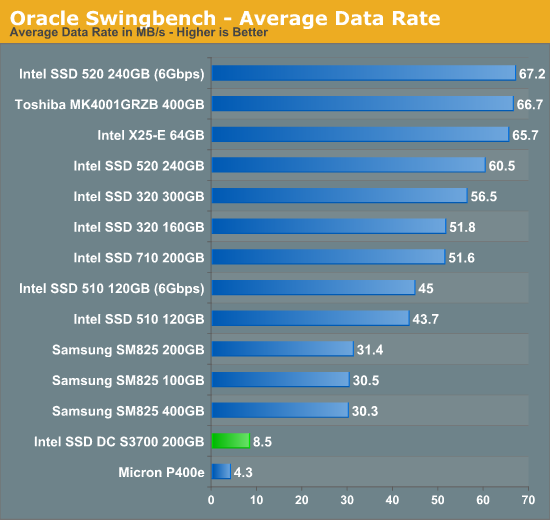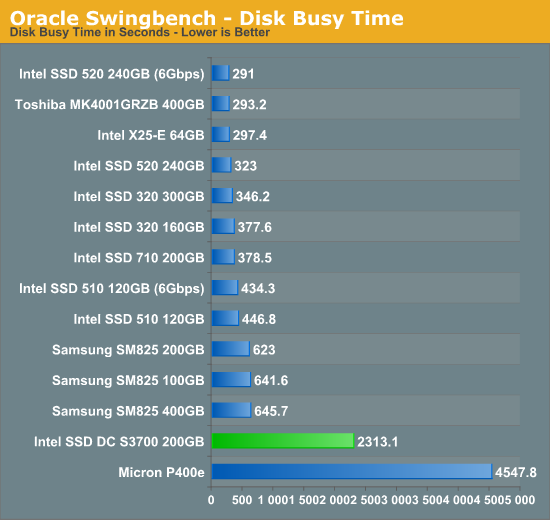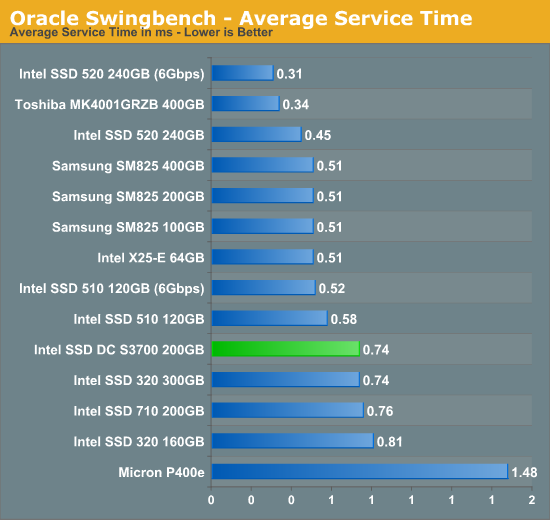The Intel SSD DC S3700 (200GB) Review
by Anand Lal Shimpi on November 9, 2012 8:01 AM EST- Posted in
- Cloud Computing
- Storage
- IT Computing
- SSDs
- Intel
Enterprise Storage Bench - Oracle Swingbench
We begin with a popular benchmark from our server reviews: the Oracle Swingbench. This is a pretty typical OLTP workload that focuses on servers with a light to medium workload of 100 - 150 concurrent users. The database size is fairly small at 10GB, however the workload is absolutely brutal.
Swingbench consists of over 1.28 million read IOs and 3.55 million writes. The read/write GB ratio is nearly 1:1 (bigger reads than writes). Parallelism in this workload comes through aggregating IOs as 88% of the operations in this benchmark are 8KB or smaller. This test is actually something we use in our CPU reviews so its queue depth averages only 1.33.

The S3700's only performance blemish is here in our Swingbench test. Like many other new drives we've looked at (e.g. Intel's SSD 910, Micron's P320h), the S3700's performance here is a regression compared to previous drives. I asked Intel about this and it appears that largely unaligned smaller-than-4KB accesses are slower on the new controller compared to the outgoing 710. My guess is that given how common 4KB accesses are, most controller vendors picked it as the optimization point for their next-gen drives. I'm not entirely sure how many enterprise applications exist that fall into this behavior pattern but it's worth pointing out in case you have a unique workload that features a lot of < 4KB unaligned accesses.
Update: I have some more clarification as to what's going on here. There are two components to the Swingbench test we're running here: the database itself, and the redo log. The redo log stores all changes that are made to the database, which allows the database to be reconstructed in the event of a failure. In good DB design, these two would exist on separate storage systems, but in order to increase IO we combined them both for this test. Accesses to the DB end up being 8KB and random in nature, a definite strong suit of the S3700 as we've already shown. The redo log however consists of a bunch of 1KB - 1.5KB, QD1, sequential accesses. The S3700, like many of the newer controllers we've tested, isn't optimized for low queue depth, sub-4KB, sequential workloads like this.
Remember that with 25nm NAND, the page size grew to 8KB. Having tons of small IOs like this creates extra tracking overhead, which can require additional DRAM to maintain full performance. Intel views this type of a scenario as unlikely (apparently the latest versions of Oracle allow you to force the redo log to use 4KB sectors instead of 512B sectors, which would make these transfers 8KB - 12KB in size), and thus simply didn't optimize for it with the S3700's firmware. Intel did confirm that should customer feedback indicate this is a fairly likely scenario that it would be willing to consider some alternate solutions to improving performance here, but at this point it seems like it doesn't matter for the vast majority of use cases.












30 Comments
View All Comments
JonnyDough - Thursday, November 15, 2012 - link
There are a ton of new technologies that could replace NAND. There might even be a "betamax" or "HD DVD" in there that miss the mark and lose out to some better or cheaper tech. We'll just have to wait and see what comes to market and catches on. It won't be mere enthusiasts or gamers who decide, it will be the IT industry. It usually is.mckirkus - Tuesday, November 6, 2012 - link
On interesting point to note is that if you run benchmarks on a RAMDisk, you get random 4k write IOPS in the neighborhood of 600MB/s. So in that regard, flash has a long way to go before the 6Gbit/s limitations of SATA 3.0 really hurt enterprise performance.extide - Tuesday, November 6, 2012 - link
I am not sure I understand this. First of all random 4K against a ramdisk will be HIGHLY dependent on the hardware, and I am sure you could see wayy better numbers than 600MB/sec. Also, 600MB/sec is pretty close to 6Gbit/sec, anyways.jwilliams4200 - Friday, November 9, 2012 - link
I think mckirkus is trying to say that there is a lot of headroom before sustained 4KiB random I/O SSD throughput will saturate a SATA 6Gbps link.For example, the sustained QD32 4KiB random write speed for the S3700 is apparently less than 150MB/s (35K IOPS). It will need to double and double again before it saturates a 6Gbps SATA link
mayankleoboy1 - Saturday, November 10, 2012 - link
How long do we have to wait before SATA Express drives and interface get commercial ?justaviking - Saturday, November 10, 2012 - link
If I read this the "Update" section correctly, Oracle recommends modifying their settings to change the way the log files are written.Would it be possible to re-run the the Swingbench tests using the modified settings? I'd love to see how performance changes, especially on THIS drive, and then also on some others for comparison purposes.
blackbrrd - Saturday, November 10, 2012 - link
I am guessing most people will run their Oracle database behind a raid card with some nvram to cache, which would remove the problem if the raid controller combined the writes. It would be interesting to see the performance behind a typical raid controller card with nvram cache.iwod - Sunday, November 11, 2012 - link
I am a regular Anandtech Reader, ( actually it is on my RSS Feeds so i read it everyday ) and i dont ever record Anand doing a Review on Toshiba SSD. So when i saw the performance of the MK4001 i had to look it up in Google to know it is an SAS SLC Enterprise SSD.The article did eventually have a brief mention of its Spec. But i thought it was very late in the article. Would have help it the spec was actually listed out before hand.
It seems to me the Magic is actually in the software and not the hardware. A 1:1 mapping of NAND data Address table making Random Read and Write a consistent behaviour seems more like Software magic and could easily be made on any other SSD Controller with enough amount of RAM in it. The only hardware side of things that requires this tweak is ECC Memory.
And again we are fundamentally limited by Port Speed.
mmrezaie - Monday, November 12, 2012 - link
I agree!alamundo - Monday, November 12, 2012 - link
Given the enterprise focus, this drive seems to be competitive with the Intel 910 PCI card. It would be interesting to see the 3700 benchmarked against the 910.